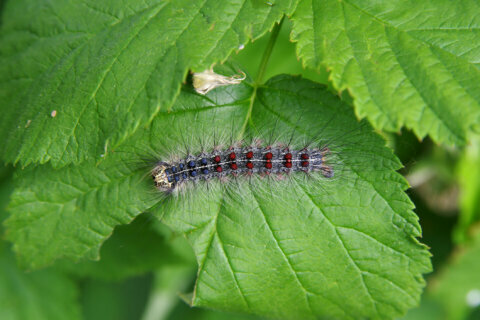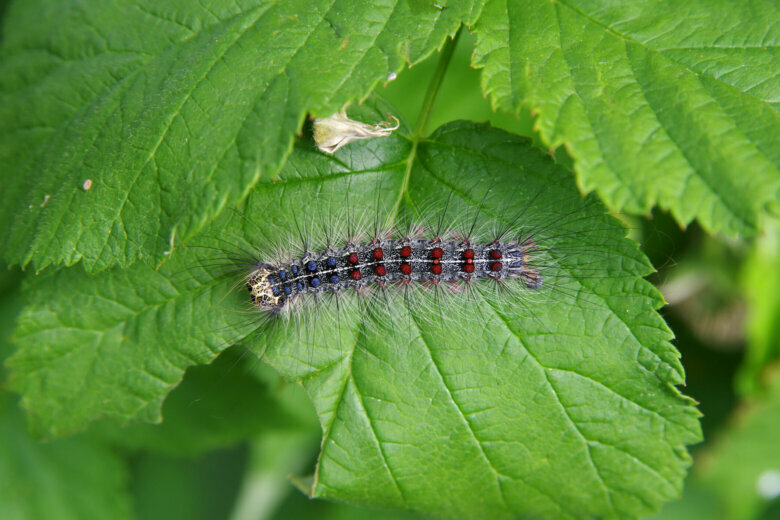
Mark Boltz-Robinson looks forward to growing apples and berries every year. The fruits go into pies, apple crisps and jams and other goodies that he sends to family in Germany.
After the coronavirus pandemic, he’d hoped to use the harvest to renew the relationships that have been difficult to maintain over the past year.
But that’s impossible since gypsy moth caterpillars wiped his trees and bushes clean this year. Instead of up to 90 pounds of apples and 18 quarts of berries, Boltz-Robinson says all he has are bare branches.
“Normally the things that I am able to make and pass to friends and family members is not going to happen this year,” he told CNN. “It’s devastating.”
As the tree warden for Monkton, Vermont, and chair of the town’s Forest Committee, Boltz-Robinson is familiar with arboreal nuisances and outbreaks. This year’s gypsy moth invasion is the worst Vermont has seen in 30 years, he said.
“I grew up in Vermont and I remember some bad years in the late 1980s, and I have never seen anything this bad,” he said.
European gypsy moths are an invasive species. They were introduced to the US in the late 19th century by a French scientist, Étienne Léopold Trouvelot, who wanted to breed a new species of silk moth in Massachusetts, according to the US Department of Agriculture.
Since then, the US has seen outbreaks of gypsy moth caterpillars every six to eight years, according to Margaret Skinner, an entomologist and researcher with the University of Vermont and its extension program.
A legion of larvae
European gypsy moth larvae — otherwise known as caterpillars — eat the foliage of hundreds of trees, according to the USDA, including oak and aspen.
Caterpillars emerge from eggs in the spring and feed on foliage until June or July, at which point they transition to an adult gypsy moth. The adults are alive for a matter of days — just enough time to mate and lay eggs on trees, which will mature through the winter.
Gypsy moths have spread beyond New England, where they were first introduced to the US. According to the USDA, the larval moths are affecting the Midwest, the Northeast, and some Southern states.
This year in particular, the larvae are legion. Officials are calling it the worst outbreak in recent memory.
“For years, people weren’t experiencing them in outbreak levels,” said Toby Petrice, a USDA research entomologist in Lansing, Michigan. “It’s been unbelievable to see how much of an impact they can have.”
An infestation of gypsy moth caterpillars can have a ripple effect, Petrice said. As the caterpillars spread, they affect wildlife, timber production, recreation, and the overall health of the forest. And if the population of caterpillars grows large enough, they move on from trees to other vegetation, like crops.
Kathy Decker, manager of the Vermont Department of Forests, Parks and Recreation’s forest protection program, told CNN the pandemic grounded the department’s aerial forest inspections. Social distancing regulations in March and April kept the department from being able to crew the small planes, she said, which kept authorities from catching the outbreak until it was too far along.
The USDA says that “early detection is critical to limiting the (European gypsy moth’s) spread.”
Several experts who spoke with CNN said that there were small-scale steps that could limit the damage to trees. Boltz-Robinson said that wrapping a tree in burlap sprayed with glue, or with duct tape facing outward, can trap the larvae on their way up a tree trunk.
“It’s effective on a small scale, but if you have 10 acres of trees that’s an awful lot of duct tape,” he said.
Skinner suggested physically removing caterpillar eggs, though recommended wearing gloves, masks, and long-sleeved clothing to do so. Gypsy moth caterpillars have been known to cause skin rash and respiratory problems in some people, according to the USDA.
Drought is playing a role in outbreak
The problem is ultimately environmental. Decker said she is hoping for rain, which would promote the growth of a fungus that kills the caterpillars and keeps the population in check.
As of Thursday, more than half of Vermont was in a moderate drought, according to the US Drought Monitor. Year-to-date rainfall in the Northeast is 6 inches below what’s normal for this time of year.
If the drought continues, Decker said it is likely there will be more defoliation next year.
Sandy Liebhold, a research entomologist with the US Forest Service, said that the damage from this year’s outbreak was set to be on par with previous large outbreaks.
“In the 1980s, there was 12 million acres defoliation, and in the 1990s, 17 million acres,” he said. “Between a million and 10 million acres of forests are expected to be defoliated over the next year due to this year’s outbreak.”
What’s unique about the 2021 outbreak, Liebhold said, is that the caterpillars are being found further north than before — even into Ontario, where he said the gypsy moth population is likely the largest.
“Whether conditions have shifted to make them more favorable in the North than the South, we don’t know,” he added.
Boltz-Robinson, the Vermont tree warden, partially attributes the severity of this year’s outbreak to the pandemic and the inability to take preventative measures.
But he also points to climate change. Extreme drought has hindered the growth of some natural funguses that are repellent to the caterpillars, he said.
“And my personal opinion, it’s only going to get worse from here without any significant change,” he said.








